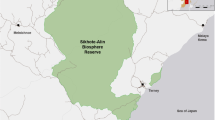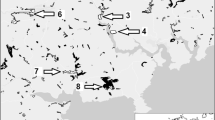Abstract
Habitat fragmentation causes negative population trends or even local extinction in many species. Understanding the role of fragmentation on behavior and space use of animals is an essential part of revealing the mechanism behind observed population declines. We studied experimentally the effects of small-scale habitat fragmentation on the distribution and movement of bank voles (Myodes glareolus) in seminatural enclosures. We predicted that besides habitat structure, availability of two resources, food for both sexes, and receptive females for males, determine individual distribution. We manipulated female density (either 0, 4, or 12 per enclosure) and followed movements of radio-collared males. We also studied the effect of unequal food distribution between the fragments on vole distribution. The habitat of 0.25-ha enclosures was manipulated by forming either one large, two medium-sized, or four small habitat patches surrounded by an inhospitable matrix. Female density and distribution clearly affected male spacing behavior. Males had larger home ranges in the medium female density enclosures. Furthermore, the use of the inhospitable and risky matrix area increased with habitat fragmentation. Food supplementation improved individual condition measured as body mass but did not affect breeding success. Our experiments demonstrated that both small-scale habitat fragmentation and resource distribution affect the behavior and condition of individuals. Increased fragmentation led to increased risk taking in both mating and foraging behavior. This should have direct survival and fitness consequences, and therefore our results may be extrapolated to population-level consequences of habitat fragmentation.




Similar content being viewed by others
References
Andreassen HP, Ims RA (2001) Dispersal in patchy vole populations: role of patch configuration, density dependence, and demography. Ecology 82:2911–2926
Andreassen HP, Hertzberg K, Ims RA (1998) Space-use responses to habitat fragmentation and connectivity in the root vole Microtus oeconomus. Ecology 79:1223–1235
Bjørnstad ON, Andreassen HP, Ims RA (1998) Effects of habitat patchiness and connectivity on the spatial ecology of the root vole Microtus oeconomus. J Anim Ecol 67:127–140. doi:10.1046/j.1365-2656.1998.00175.x
Boutin S (1990) Food supplementation experiments with terrestrial vertebrates: patterns, problems, and the future. Can J Zool 68:203–223
Cook WM, Johnson BK, Cook RC, Riggs RA, Delcurto T, Bryant LD, Irwin LL (2004) Is the matrix really inhospitable? Vole runway distribution in an experimentally fragmented landscape. Oikos 104:5–14. doi:10.1111/j.0030-1299.2004.12761.x
Davis MB, Shaw RG (2001) Range shifts and adaptive responses to quaternary climate change. Science 292:673–679. doi:10.1126/science.292.5517.673
Debinski MD, Holt DR (2000) A survey and overview of habitat fragmentation experiments. Conserv Biol 14:342–355. doi:10.1046/j.1523-1739.2000.98081.x
Diffendorfer JE, Gaines MS, Holt RD (1995) Habitat fragmentation and movements of three small mammals (Sigmodon, Microtus, and Peromyscus). Ecology 76:827–839
Erlinge S, Hoogenboom I, Agrell J, Nelson J, Sandell M (1990) Density-related home-range size and overlap in adult field voles (Microtus agrestis) in southern Sweden. J Mammal 71:597–603
Fahrig L, Merriam G (1994) Conservation of fragmented populations. Conserv Biol 8:50–59
Fretwell SD, Lucas HL (1970) On territorial behaviour and other factors influencing habitat distribution in birds. Theoretical development. Acta Biotheor 19:16–36
Groom MJ, Vynne CH (2006) Habitat degradation and loss. In: Groom MJ, Meffe GM, Caroll CR (eds) Principles of conservation biology. Sinauer, Sunderland, pp 173–212
Hanski I, Gilpin ME (1997) Metapopulation biology: ecology, genetics, and evolution. Academic Press, London
Henle K, Davies KF, Kleyer M, Margules C, Settele J (2004) Predictors of species sensitivity to fragmentation. Biodivers Conserv 13:207–251. doi:10.1023/B:BIOC.0000004319.91643.9e
Ims RA (1987) Responses in spatial organization and behaviour to manipulations of the food resource in the vole Clethrionomys rufocanus. J Anim Ecol 56:585–596
Ims RA (1988) Spatial clumping of sexually receptive females induces space sharing among male voles. Nature 335:541–543
Ims RA, Rolstad J, Wegge P (1993) Predicting space use responses to habitat fragmentation: can voles Microtus oeconomus serve as an experimental model system (EMS) for capercaillie grouse Tetrao urogallus in boreal forest? Biol Conserv 63:261–268
Johannesen E, Ims RA (1996) Modelling survival rates: habitat fragmentation and destruction in root vole experimental populations. Ecology 77:1196–1209
Johannesen E, Aars J, Andreassen HP, Ims RA (2003) A demographic analysis of vole population responses to fragmentation and destruction of habitat. Popul Ecol 45:47–58. doi:10.1007/s10144-003-0139-7
Kalela O (1957) Regulation of reproduction rate in subartic populations of the vole Clethriononys rufocanus (sund.). Ann Acad Sci Fenn A IV Biol 34:1–60
Koskela E, Horne TJ, Mappes T, Ylönen H (1996) Does risk of small mustelid predation affect the oestrous cycle in the bank vole, Clethrionomys glareolus? Anim Behav 51:1159–1163. doi:10.1006/anbe.1996.0117
Kotler BP, Brown JS, Hasson O (1991) Factors affecting gerbil foraging behavior and rates of owl predation. Ecology 72:2249–2260
Kotler B, Ayal Y, Subach A (1994) Effects of predatory risk and resource renewal on the timing of foraging activity in a gerbil community. Oecologia 100:391–396
Lin YTK, Batzli GO (2001) The influence of habitat quality on dispersal, demography, and population dynamics of voles. Ecol Monogr 71:245–275
Lin YTK, Batzli GO (2004) Movement of voles across habitat boundaries: Effects of food and cover. J Mammal 85:216–224
MA (Millennium Ecosystem Assessment) (2005) Ecosystems and human well-being: Biodiversity synthesis. World Resources Institute, Washington, DC
Primack RB (1998) Essentials of conservation biology. Sinauer, Sunderland
Pusenius J, Schmidt KA (2002) The effects of habitat manipulation on population distribution and foraging behavior in meadow voles. Oikos 98:251–262. doi:10.1034/j.1600-0706.2002.980207.x
Pusenius J, Ostfeld RS, Keesing F (2000) Patch selection and tree-seedling predation by resident vs. immigrant meadow voles. Ecology 81:2951–2956
Rolstad J (1991) Consequences of forest fragmentation for the dynamics of bird populations: conceptual issues and the evidence. Biol J Linn Soc 42:149–163
Smith JE, Batzli GO (2006) Dispersal and mortality of prairie voles (Microtus ochrogaster) in fragmented landscapes: a field experiment. Oikos 112:209–217. doi:10.1111/j.0030-1299.2006.13431.x
Stenseth NC (1985) Geographic distribution of Clethrionomys species. Ann Zool Fenn 22:215–219
Sundell J, Trebatická L, Oksanen T, Ovaskainen O, Haapakoski M, Ylönen H (2008) Predation on two vole species by a shared predator: antipredatory response and prey preference. Popul Ecol 50:257–266. doi:10.1007/s10144-008-0086-4
Von Blanckenhagen F, Eccard J, Ylönen H (2007) Animal protein as a reproductive constraint in spring reproduction of the bank vole. Ecoscience 14:323–329. doi:10.2980/1195-6860(2007)14[323:APAARC]2.0.CO;2
Walther G, Post E, Convey P, Menzel A, Parmesan C, Beebee TJC, Fromentin J-M, Hoegh-Guldberg O, Bairlein F (2002) Ecological responses to recent climate change. Nature 416:389–395. doi:10.1038/416389a
Wrangham RW, Smuts BB (1980) Sex differences in the behavioural ecology of chimpanzees in the Gombe national park, Tanzania. J Reprod Fertil 28:13–31
Ylönen H, Brown JS (2007) Fear and the foraging, breeding and sociality in rodents. In: Wolff JO, Sherman PW (eds) Rodent societies. University of Chicago Press, Chicago, pp 328–241
Ylönen H, Mappes T (1995) Spacing behavior and key resources: an experiment on seasonal preference of male bank voles, Clethrionomys glareolus, for food and females. Ann Zool Fenn 32:445–448
Ylönen H, Kojola T, Viitala J (1988) Changing female spacing behaviour and demography in an enclosed breeding population of Clethrionomys glareolus. Holarct Ecol 11:286–292
Ylönen H, Jacob J, Davies MJ, Singleton GR (2002) Predation risk and habitat selection of Australian house mice (Mus domesticus) during an incipient plague: desperate behaviour due to food depletion. Oikos 99:285–290. doi:10.1034/j.1600-0706.2002.990208.x
Acknowledgments
We thank technicians of the Konnevesi Research Station, Risto Latvanen, Jyrki Raatikainen and Janne Koskinen, for their hard work in cutting and removing grass from the enclosures. Elina Puolakka, Kaisa Rokka, Anni Hämäläinen, Lenka Trebaticka and Dagmar Lorch helped in the laboratory and in the field. Janne Sundell, Katri Korpela and Erlend Birkeland Nilsen made valuable comments on the manuscript. Heikki Helle helped with statistics. All experiments were complied with permission for animal experimentation at the University of Jyväskylä.
Author information
Authors and Affiliations
Corresponding author
Rights and permissions
About this article
Cite this article
Haapakoski, M., Ylönen, H. Effects of fragmented breeding habitat and resource distribution on behavior and survival of the bank vole (Myodes glareolus). Popul Ecol 52, 427–435 (2010). https://doi.org/10.1007/s10144-010-0193-x
Received:
Accepted:
Published:
Issue Date:
DOI: https://doi.org/10.1007/s10144-010-0193-x




